In the realm of parenting, the decision to wean a child off the pacifier is laden with differing opinions and personal anecdotes. On one side, some experts advocate for early weaning, suggesting that by the age of 12 months, children should transition away from their reliance on this soothing tool. Conversely, there are those who argue that weaning should be a child-led process, allowing the little ones to determine their own readiness. In this article, I will navigate this multifaceted issue and share nuanced perspectives that cater to the unique needs of every child.
Pacifiers offer a comforting mechanism for infants, fulfilling a natural developmental need to suck that can ease transition periods, such as falling asleep. There is considerable evidence supporting this practice; studies indicate that pacifiers may lower the risk of Sudden Infant Death Syndrome (SIDS) and even alleviate pain during minor procedures in infants. For preterm babies, the benefits extend further, as non-nutritive sucking has been associated with improved feeding and shorter hospital stays. Yet, while pacifiers can be a boon during infancy, various considerations must guide their long-term usage.
The Double-Edged Sword: Potential Downsides of Pacifier Use
However, not all that glitters is gold. The American Academy of Family Physicians highlights significant concerns about prolonged pacifier use. For many children, reliance on a pacifier past the age of two can lead to dental issues, and the risks only escalate as children grow older. One alarming statistic reveals that malocclusion affects a staggering 71% of children who continue to use pacifiers or suck their thumbs beyond the age of four. Notably, the guidelines from the American Dental Association recommend discouraging pacifier use after age four for good reason.
Moreover, hygiene is a valid concern—studies have shown that pacifiers can become breeding grounds for bacteria, potentially leading to ear infections. This raises an important question for parents: how do we balance the comforting aspects of pacifier use with its possible negative outcomes? This delicate dance requires a personalized approach centered on the child’s individuality.
The Weaning Journey: Finding What Works for Your Child
When it comes to weaning from the pacifier, the path is not one-size-fits-all. Each child is different, and what works for one might not resonate with another. One of the most gentle approaches involves allowing the child to self-wean, a method where children typically shed their pacifier between the ages of three and four. It can be a stress-free way of saying goodbye to the binky, rooted in respect for the child’s natural development.
If your child shows signs of reluctance in parting with their beloved pacifier, consider introducing a bit of magic into the equation. The concept of a “Binky Fairy” can transform the process into an enchanting experience, where your child can happily offer up their pacifiers in exchange for a small reward. This creative narrative can not only lighten the “blow” of relinquishing it but also foster a sense of agency.
Of course, if your child is on the older side and shows persistent dependence on their pacifier, you might prefer a more structured plan. Gradual weaning can be very effective—start by limiting pacifier use to sleep times, progressively reducing its presence. Employ patience and empathy throughout this process. Children might struggle at first, but with warmth and support, they can adapt.
Empowering Your Parenting Choice
It’s crucial to understand that whatever decision you make regarding pacifier weaning should feel right for both you and your child. Parents often grapple with feelings of concern over whether they are making the best choices. Yet, embracing intuition and focusing on kind approaches can be incredibly reassuring. Maintain an open dialogue with your child, celebrate small victories, and reassure them that they are capable of transitioning away from the pacifier.
Through this transition, remember to imbue your heart and actions with confidence. Positivity in the language you use can create an encouraging environment. If bedtime has been associated with pacifier use, be prepared to be there to comfort your child through the adjustment phase, reinforcing their emotional security.
Parents need to realize that there is no “perfect” approach to weaning off the pacifier. And that imperfection is the very essence of parenting. Each child’s journey will be unique, marked by personal quirks and preferences, and this individuality deserves to be celebrated. Ultimately, making thoughtful, compassionate decisions can transform challenges into cherished memories shared between parent and child.

